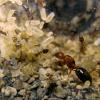1. Location (on a map) of collection: Houston, Texas
2. Date of collection: April 26, 2020
3. Habitat of collection: Suburbs
4. Length (from head to gaster): 8 mm
5. Color, hue, pattern and texture: Reddish
6. Distinguishing characteristics: None
7. Distinguishing behavior: Walks slowly and likes to hide under things.
8. Nest description: None
9. Nuptial flight time and date: April 26, 2020 at around 3 pm
Here is a picture

Edited by PlumpPotato1234, April 29 2020 - 2:11 PM.




















